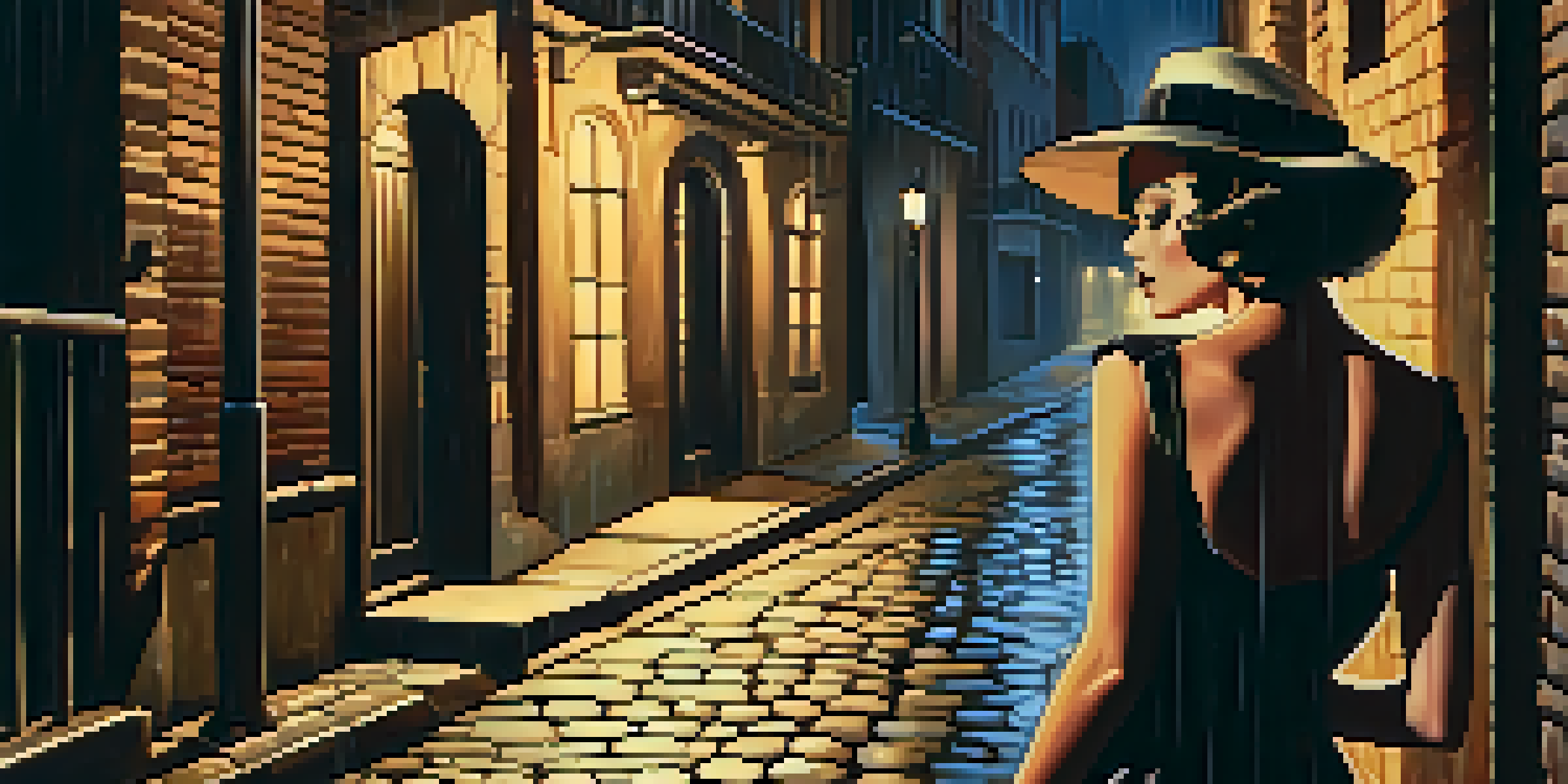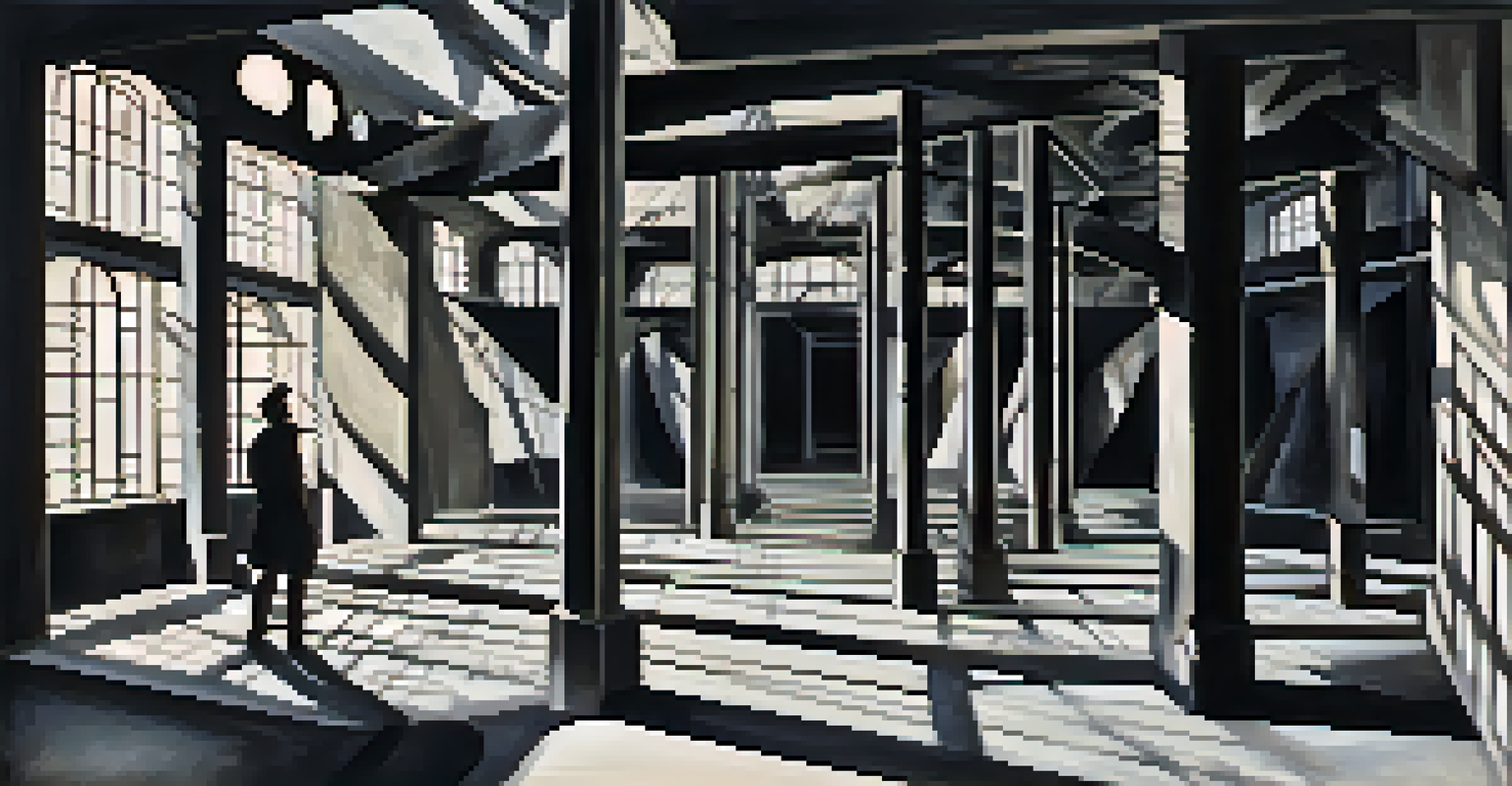The Influence of German Expressionism on Film Noir Style

Understanding German Expressionism and Its Origins
German Expressionism emerged in the early 20th century as a response to the chaos of World War I. Artists and filmmakers sought to convey emotional experiences rather than physical reality, using exaggerated visuals and distorted perspectives. This movement laid the groundwork for a new way of storytelling in cinema, focusing on internal struggles and the human psyche.
Art is a lie that makes us realize the truth.
The movement found its footing in cinema through films like 'The Cabinet of Dr. Caligari,' which featured haunting sets and stark lighting. These elements were not just for aesthetics; they represented the characters' inner turmoil and societal fears. This emphasis on mood and atmosphere became a hallmark of the genre, influencing countless filmmakers in the years to come.
As we look at the evolution of cinema, it’s clear that German Expressionism established a distinct visual language. This language would eventually seep into Hollywood, shaping genres like Film Noir. The psychological depth and stylistic choices of Expressionism created a fertile ground for the darker narratives explored in Noir films.
Defining Film Noir: Characteristics and Themes
Film Noir, prevalent from the 1940s to the late 1950s, is characterized by its cynical attitude, moral ambiguity, and complex characters. The narratives often revolve around crime, betrayal, and existential dread, reflecting the societal anxieties post-World War II. The aesthetic is marked by high-contrast lighting, shadowy visuals, and unconventional camera angles, all contributing to an overarching sense of doom.

These elements helped create a unique atmosphere that captivated audiences, drawing them into a world of suspense and intrigue. The use of femme fatales and anti-heroes further exemplified the genre's exploration of morality, mirroring the emotional intensity found in German Expressionist films. As viewers, we find ourselves grappling with the same questions of identity and reality.
German Expressionism Shapes Film Noir
The emotional and visual techniques of German Expressionism significantly influenced the storytelling and aesthetic of Film Noir.
Just as German Expressionism turned the lens on personal and societal struggles, Film Noir did the same in a postwar context. The characters, often flawed and desperate, echoed the turbulent emotions of an era marked by uncertainty. This thematic connection between the two genres highlights the enduring influence of Expressionism on the Noir style.
Visual Techniques: Shadows and Light in Film Noir
One of the most striking features of Film Noir is its use of chiaroscuro lighting—an artistic technique that juxtaposes light and dark to create drama. This technique has its roots in German Expressionism, where stark contrasts were used to evoke emotional responses. In Noir films, shadows often serve as characters themselves, hiding secrets and intensifying suspense.
In film, the story is the thing, but the visuals are the language that tells that story.
Cinematographers like John Alton and Greg Toland mastered this interplay of light and shadow, using it to shape the narrative visually. The result is a haunting ambiance that immerses viewers in the characters' psychological states. For example, in 'Double Indemnity,' the use of shadows reflects the protagonists' moral ambiguity and the lurking danger surrounding them.
This visual style not only enhances the storytelling but also creates a palpable tension that keeps audiences on the edge of their seats. The influence of German Expressionism is evident in how these filmmakers manipulated light to reflect existential themes, making the visual experience as compelling as the narrative itself.
Set Design and Atmosphere: Echoes of Expressionism
Set design in Film Noir often mirrors the distorted realities seen in German Expressionist films. The use of angular, claustrophobic spaces creates a sense of confinement and entrapment, reinforcing the characters' struggles. These sets are meticulously crafted to evoke specific moods, much like the painted backdrops used in Expressionist cinema.
Take 'The Maltese Falcon' as an example; the dark, moody interiors reflect the characters' internal conflicts and moral dilemmas. The art direction employs stark contrasts and elaborate designs to create a world that feels both familiar and unsettling. This atmosphere invites viewers to question the nature of reality and illusion.
Character Complexity in Film Noir
Film Noir features complex, flawed characters that echo the psychological depth found in German Expressionist films.
By utilizing set design to enhance the emotional landscape, Film Noir filmmakers paid homage to their Expressionist predecessors. The resulting environments not only serve as backdrops but also become integral components of the storytelling process, echoing the psychological depth that both genres seek to explore.
Characterization: Complex Figures in Noir
Characters in Film Noir often reflect the same psychological complexities found in German Expressionism. They are frequently flawed, tormented individuals grappling with their own demons, much like the protagonists in Expressionist films. This shared focus on character psychology invites viewers to delve into the darker aspects of the human experience.
The archetype of the femme fatale, a staple in Noir, exemplifies this complexity. These characters embody both allure and danger, challenging traditional gender roles and presenting moral ambiguity. In films like 'Gilda,' the femme fatale is both a source of desire and a harbinger of doom, paralleling the duality often present in Expressionist character portrayals.
By presenting characters that are deeply flawed and morally ambiguous, Film Noir continues the Expressionist legacy of exploring the human condition. This emphasis on character depth invites audiences to engage with the narrative on a more personal level, making the stories resonate long after the credits roll.
Cinematography: The Artistic Lens of Noir
Cinematography plays a pivotal role in establishing the tone of Film Noir, drawing heavily from techniques pioneered in German Expressionism. The use of unconventional angles and framing creates a sense of unease and disorientation, immersing viewers in the characters' turmoil. This stylistic choice is a direct nod to the Expressionist emphasis on visual storytelling.
For instance, low-angle shots can make characters appear larger than life, emphasizing their power or desperation. In contrast, high-angle shots may evoke vulnerability, aligning the audience with the characters’ struggles. Cinematographers like Nicholas Musuraca in 'Out of the Past' expertly utilized these techniques to enhance the psychological drama at play.
Legacy of Visual Storytelling
The enduring connection between German Expressionism and Film Noir continues to impact contemporary cinema's exploration of identity and reality.
Through innovative cinematographic choices, Film Noir captures the essence of human emotions and conflicts. This artistic lens not only serves the narrative but also pays homage to the visual experimentation of German Expressionism, creating a rich tapestry of storytelling that resonates with viewers.
Legacy and Influence: The Enduring Connection
The influence of German Expressionism on Film Noir continues to be felt in contemporary cinema. Filmmakers today often draw inspiration from the visual and thematic elements that defined both genres, creating a lasting legacy. The exploration of psychological complexity and moral ambiguity remains a powerful narrative device across various film styles.
Modern films like 'Sin City' and 'Blade Runner 2049' exhibit a clear influence from both German Expressionism and Film Noir. These films utilize striking visuals, complex characters, and intricate narratives to explore themes of identity and reality. This connection underscores the timeless appeal of these artistic movements.

Ultimately, the interplay between German Expressionism and Film Noir showcases the evolving nature of storytelling in film. As filmmakers continue to explore the human experience through visually compelling narratives, the influence of these genres will undoubtedly persist, reminding us of their shared artistic heritage.